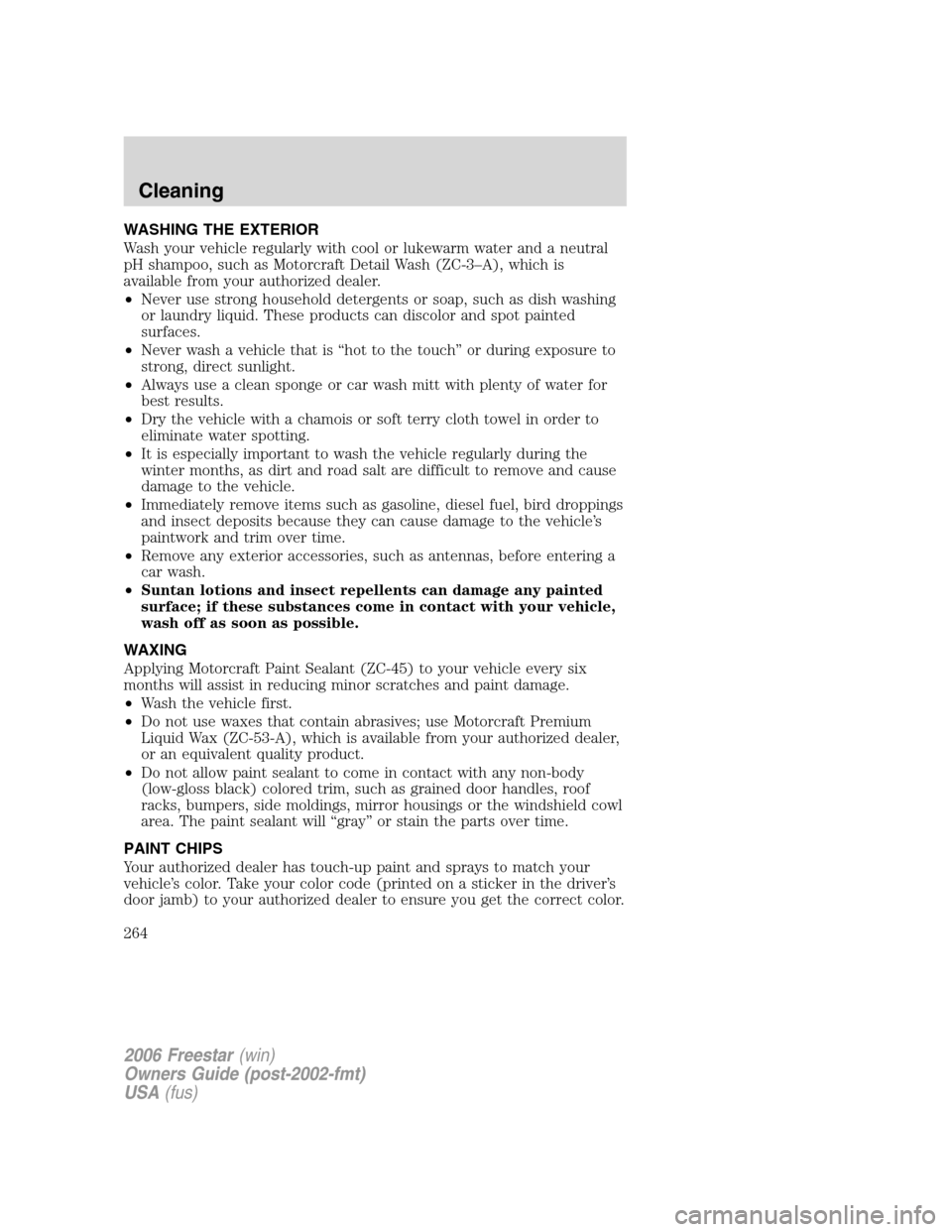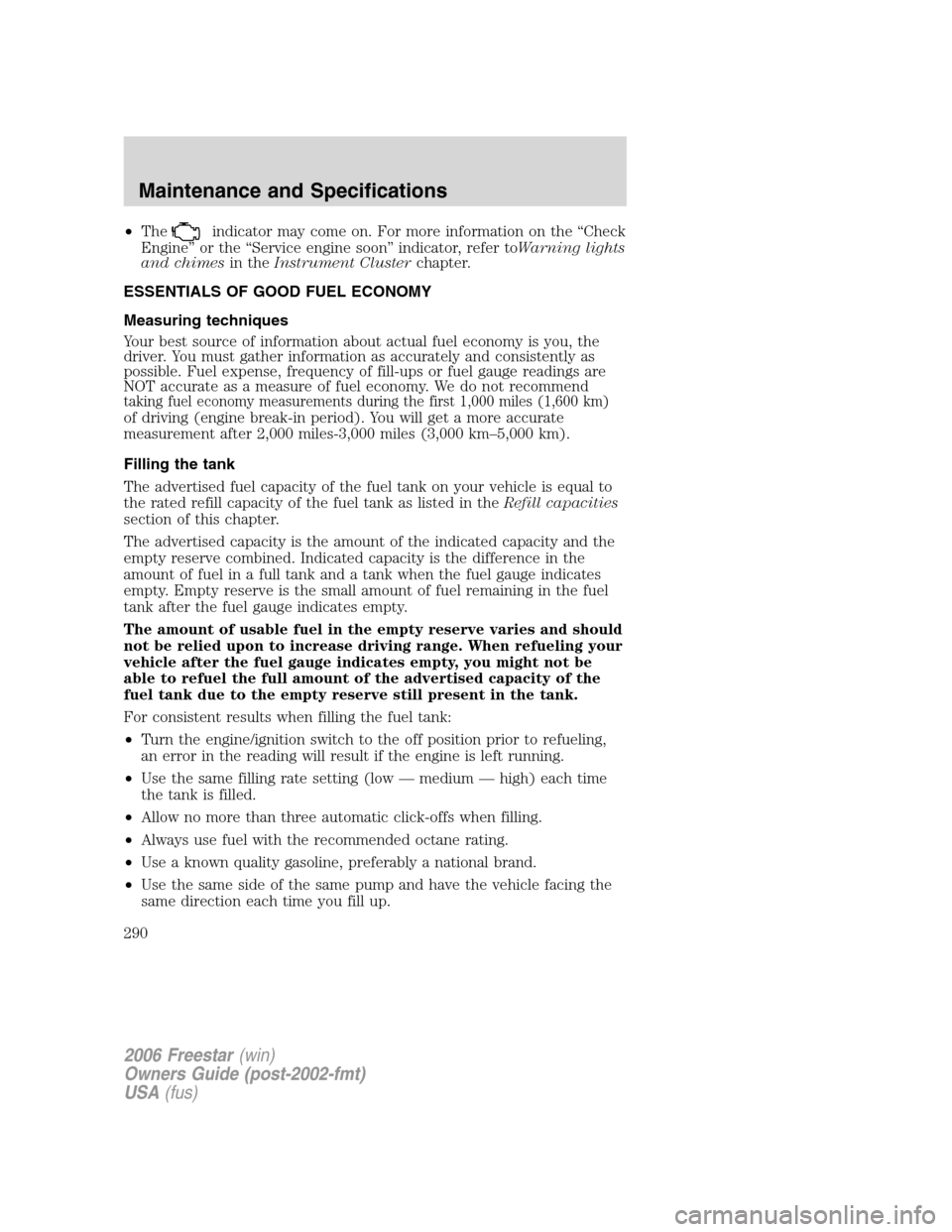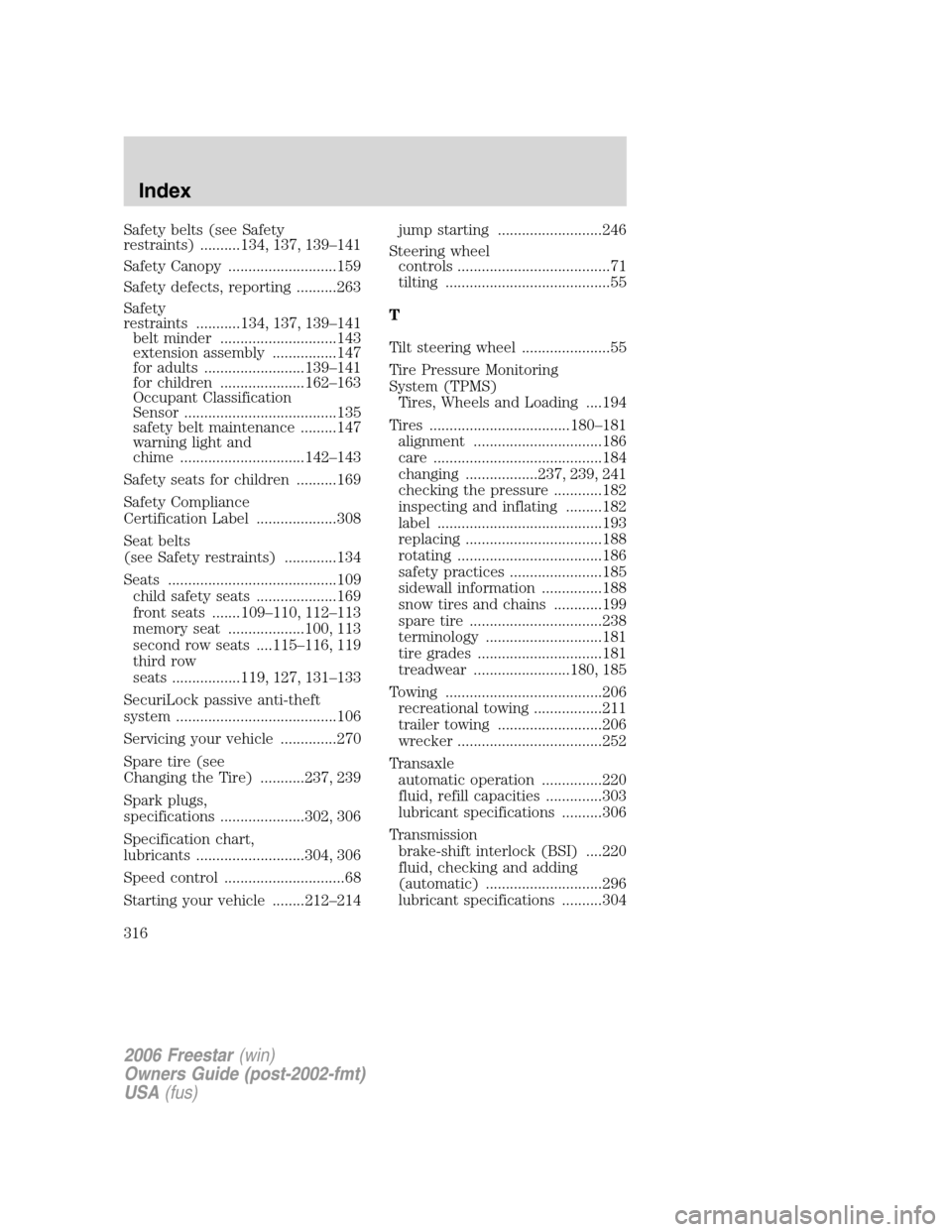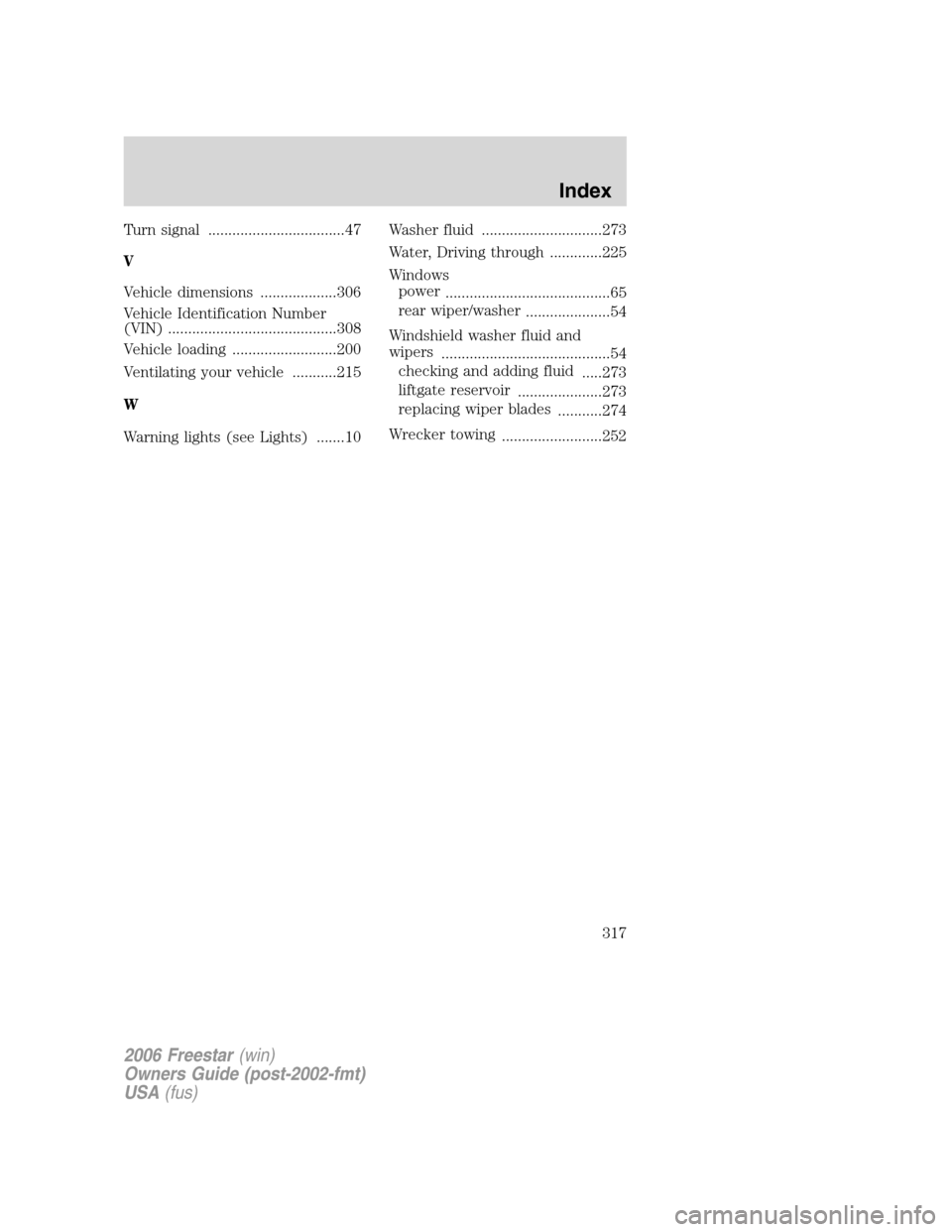2006 FORD FREESTAR tow
[x] Cancel search: towPage 264 of 320

WASHING THE EXTERIOR
Wash your vehicle regularly with cool or lukewarm water and a neutral
pH shampoo, such as Motorcraft Detail Wash (ZC-3–A), which is
available from your authorized dealer.
•Never use strong household detergents or soap, such as dish washing
or laundry liquid. These products can discolor and spot painted
surfaces.
•Never wash a vehicle that is “hot to the touch” or during exposure to
strong, direct sunlight.
•Always use a clean sponge or car wash mitt with plenty of water for
best results.
•Dry the vehicle with a chamois or soft terry cloth towel in order to
eliminate water spotting.
•It is especially important to wash the vehicle regularly during the
winter months, as dirt and road salt are difficult to remove and cause
damage to the vehicle.
•Immediately remove items such as gasoline, diesel fuel, bird droppings
and insect deposits because they can cause damage to the vehicle’s
paintwork and trim over time.
•Remove any exterior accessories, such as antennas, before entering a
car wash.
•Suntan lotions and insect repellents can damage any painted
surface; if these substances come in contact with your vehicle,
wash off as soon as possible.
WAXING
Applying Motorcraft Paint Sealant (ZC-45) to your vehicle every six
months will assist in reducing minor scratches and paint damage.
•Wash the vehicle first.
•Do not use waxes that contain abrasives; use Motorcraft Premium
Liquid Wax (ZC-53-A), which is available from your authorized dealer,
or an equivalent quality product.
•Do not allow paint sealant to come in contact with any non-body
(low-gloss black) colored trim, such as grained door handles, roof
racks, bumpers, side moldings, mirror housings or the windshield cowl
area. The paint sealant will “gray” or stain the parts over time.
PAINT CHIPS
Your authorized dealer has touch-up paint and sprays to match your
vehicle’s color. Take your color code (printed on a sticker in the driver’s
door jamb) to your authorized dealer to ensure you get the correct color.
2006 Freestar(win)
Owners Guide (post-2002-fmt)
USA(fus)
Cleaning
264
Page 274 of 320

CHANGING THE WIPER BLADES
To replace the wiper blades:
1. Pull the wiper arm away from the
windshield and lock into the service
position.
2. Turn the blade at an angle from
the wiper arm. Push the lock pin
manually to release the blade and
pull the wiper blade down toward
the windshield to remove it from the
arm.
3. Attach the new wiper to the
wiper arm and press it into place
until a click is heard.
Replace wiper blades at least once per year for optimum performance.
Poor wiper quality can be improved by cleaning the wiper blades and
windshield, refer toWindows and wiper bladesin theCleaning
chapter.
To prolong the life of the wiper blades, it is highly recommended to
scrape off the ice on the windshield before turning on the wipers. The
layer of ice has many sharp edges and can damage the micro edge of the
wiper rubber element.
ENGINE OIL
Checking the engine oil
Refer to thescheduled maintenance informationfor the appropriate
intervals for checking the engine oil.
1. Make sure the vehicle is on level ground.
2. Turn the engine off and wait a few minutes for the oil to drain into the
oil pan.
3. Set the parking brake and ensure the gearshift is securely latched in P
(Park).
4. Open the hood. Protect yourself from engine heat.
2006 Freestar(win)
Owners Guide (post-2002-fmt)
USA(fus)
Maintenance and Specifications
274
Page 290 of 320

•Theindicator may come on. For more information on the “Check
Engine” or the “Service engine soon” indicator, refer toWarning lights
and chimesin theInstrument Clusterchapter.
ESSENTIALS OF GOOD FUEL ECONOMY
Measuring techniques
Your best source of information about actual fuel economy is you, the
driver. You must gather information as accurately and consistently as
possible. Fuel expense, frequency of fill-ups or fuel gauge readings are
NOT accurate as a measure of fuel economy. We do not recommend
taking fuel economy measurements during the first 1,000 miles (1,600 km)
of driving (engine break-in period). You will get a more accurate
measurement after 2,000 miles-3,000 miles (3,000 km–5,000 km).
Filling the tank
The advertised fuel capacity of the fuel tank on your vehicle is equal to
the rated refill capacity of the fuel tank as listed in theRefill capacities
section of this chapter.
The advertised capacity is the amount of the indicated capacity and the
empty reserve combined. Indicated capacity is the difference in the
amount of fuel in a full tank and a tank when the fuel gauge indicates
empty. Empty reserve is the small amount of fuel remaining in the fuel
tank after the fuel gauge indicates empty.
The amount of usable fuel in the empty reserve varies and should
not be relied upon to increase driving range. When refueling your
vehicle after the fuel gauge indicates empty, you might not be
able to refuel the full amount of the advertised capacity of the
fuel tank due to the empty reserve still present in the tank.
For consistent results when filling the fuel tank:
•Turn the engine/ignition switch to the off position prior to refueling,
an error in the reading will result if the engine is left running.
•Use the same filling rate setting (low — medium — high) each time
the tank is filled.
•Allow no more than three automatic click-offs when filling.
•Always use fuel with the recommended octane rating.
•Use a known quality gasoline, preferably a national brand.
•Use the same side of the same pump and have the vehicle facing the
same direction each time you fill up.
2006 Freestar(win)
Owners Guide (post-2002-fmt)
USA(fus)
Maintenance and Specifications
290
Page 292 of 320

•Revving the engine before turning it off may reduce fuel economy.
•Using the air conditioner or defroster may reduce fuel economy.
•You may want to turn off the speed control in hilly terrain if
unnecessary shifting between third and fourth gear occurs.
Unnecessary shifting of this type could result in reduced fuel
economy.
•Warming up a vehicle on cold mornings is not required and may
reduce fuel economy.
•Resting your foot on the brake pedal while driving may reduce fuel
economy.
•Combine errands and minimize stop-and-go driving.
Maintenance
•Keep tires properly inflated and use only recommended size.
•Operating a vehicle with the wheels out of alignment will reduce fuel
economy.
•Use recommended engine oil. Refer toLubricant specificationsin
this chapter.
•Perform all regularly scheduled maintenance items. Follow the
recommended maintenance schedule and owner maintenance checks
found inscheduled maintenance information.
Conditions
•Heavily loading a vehicle or towing a trailer may reduce fuel economy
at any speed.
•Carrying unnecessary weight may reduce fuel economy (approximately
1 mpg [0.4 km/L] is lost for every 400 lb [180 kg] of weight carried).
•Adding certain accessories to your vehicle (for example bug
deflectors, rollbars/light bars, running boards, ski/luggage racks) may
reduce fuel economy.
•Using fuel blended with alcohol may lower fuel economy.
•Fuel economy may decrease with lower temperatures during the first
8–10 miles (12–16 km) of driving.
•Driving on flat terrain offers improved fuel economy as compared to
driving on hilly terrain.
•Transmissions give their best fuel economy when operated in the top
cruise gear and with steady pressure on the gas pedal.
•Close windows for high speed driving.
2006 Freestar(win)
Owners Guide (post-2002-fmt)
USA(fus)
Maintenance and Specifications
292
Page 316 of 320

Safety belts (see Safety
restraints) ..........134, 137, 139–141
Safety Canopy ...........................159
Safety defects, reporting ..........263
Safety
restraints ...........134, 137, 139–141
belt minder .............................143
extension assembly ................147
for adults .........................139–141
for children .....................162–163
Occupant Classification
Sensor ......................................135
safety belt maintenance .........147
warning light and
chime ...............................142–143
Safety seats for children ..........169
Safety Compliance
Certification Label ....................308
Seat belts
(see Safety restraints) .............134
Seats ..........................................109
child safety seats ....................169
front seats .......109–110, 112–113
memory seat ...................100, 113
second row seats ....115–116, 119
third row
seats .................119, 127, 131–133
SecuriLock passive anti-theft
system ........................................106
Servicing your vehicle ..............270
Spare tire (see
Changing the Tire) ...........237, 239
Spark plugs,
specifications .....................302, 306
Specification chart,
lubricants ...........................304, 306
Speed control ..............................68
Starting your vehicle ........212–214jump starting ..........................246
Steering wheel
controls ......................................71
tilting .........................................55
T
Tilt steering wheel ......................55
Tire Pressure Monitoring
System (TPMS)
Tires, Wheels and Loading ....194
Tires ...................................180–181
alignment ................................186
care ..........................................184
changing ..................237, 239, 241
checking the pressure ............182
inspecting and inflating .........182
label .........................................193
replacing ..................................188
rotating ....................................186
safety practices .......................185
sidewall information ...............188
snow tires and chains ............199
spare tire .................................238
terminology .............................181
tire grades ...............................181
treadwear ........................180, 185
Towing .......................................206
recreational towing .................211
trailer towing ..........................206
wrecker ....................................252
Transaxle
automatic operation ...............220
fluid, refill capacities ..............303
lubricant specifications ..........306
Transmission
brake-shift interlock (BSI) ....220
fluid, checking and adding
(automatic) .............................296
lubricant specifications ..........304
2006 Freestar(win)
Owners Guide (post-2002-fmt)
USA(fus)
Index
316
Page 317 of 320

Turn signal ..................................47
V
Vehicle dimensions ...................306
Vehicle Identification Number
(VIN) ..........................................308
Vehicle loading ..........................200
Ventilating your vehicle ...........215
W
Warning lights (see Lights) .......10Washer fluid ..............................273
Water, Driving through .............225
Windows
power
.........................................65
rear wiper/washer
.....................54
Windshield washer fluid and
wipers
..........................................54
checking and adding fluid
.....273
liftgate reservoir
.....................273
replacing wiper blades
...........274
Wrecker towing
.........................252
2006 Freestar(win)
Owners Guide (post-2002-fmt)
USA(fus)
Index
317